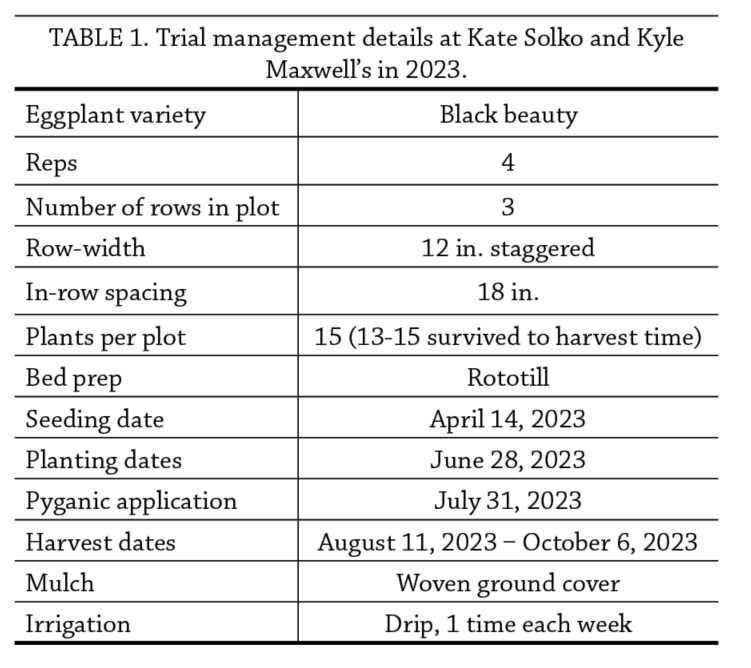This research report was funded by Stranahan Foundation.
In a Nutshell
- Brewers’ spent grain (BSG) has been shown to provide organic matter and nitrogen to soils when used as a soil amendment [1].
- Kate Solko and Kyle Maxwell of Root to Rise Farm operate on the same property as a brewery and therefore have access to a lot of free BSG. They tested using BSG as a soil amendment instead of their usual organic fertilizer, Sustane 8-2-4.
Key Findings
- Solko and Maxwell found that fertilizing with BSG more than doubled both the number of marketable eggplants and the total weight of marketable eggplant harvested compared to fertilizing with their typical Sustane rate.
Background
The spent grain left over after brewing beer (brewers’ spent grain, BSG) contains a lot of nutrients and organic matter that make it a potentially useful agricultural fertilizer [1]. Ames farmers Kate Solko and Kyle Maxwell operate Root to Rise Farm on the same property as a brewery.
They are excited about the potential of BSG as a soil amendment because using it would allow them to decrease off-farm inputs and find a use for an otherwise wasted product. It could also help their ongoing efforts to improve soil health on the farm.
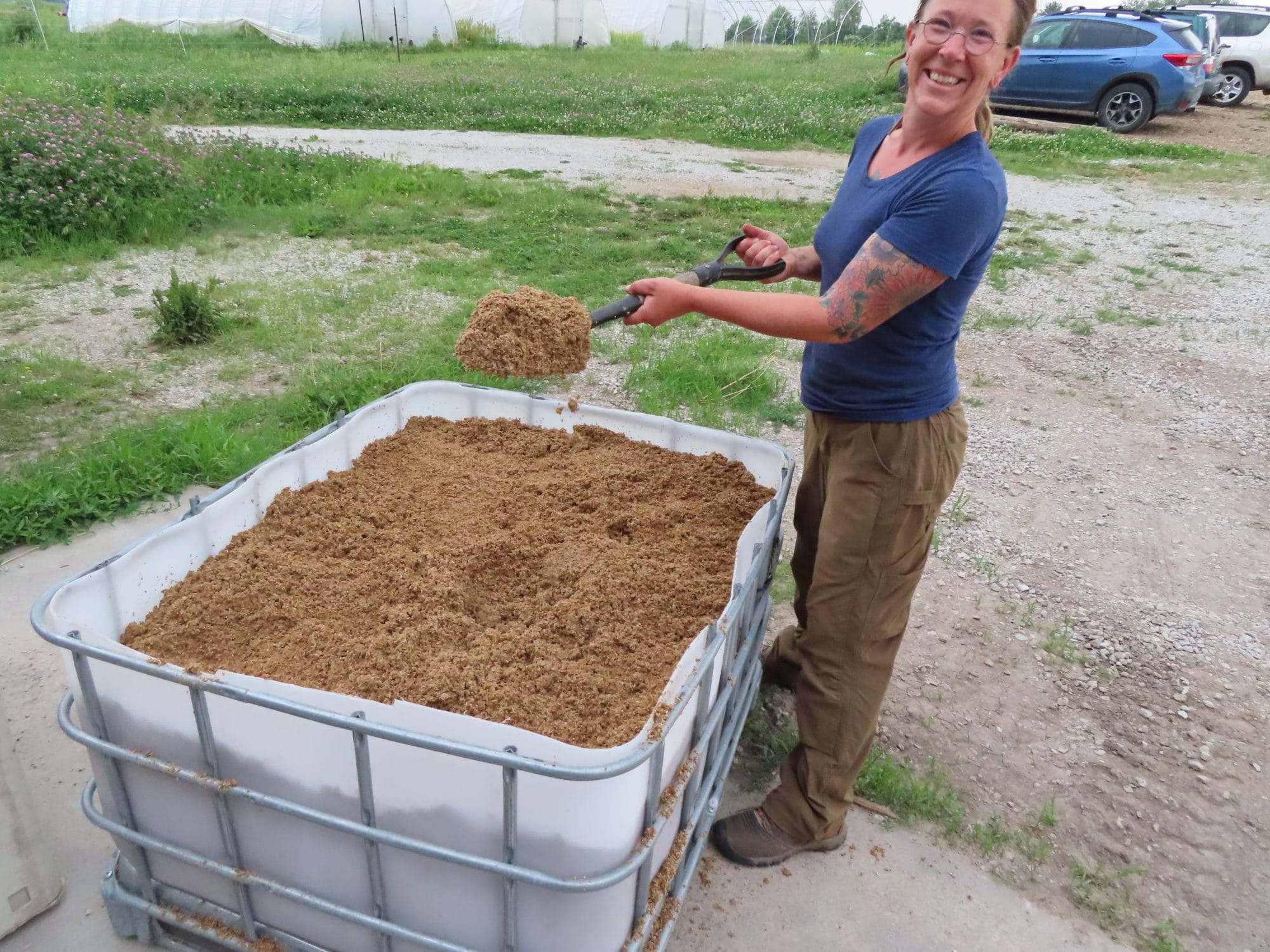
Kate Solko with brewers’ spent grain. This year, Solko and Maxwell applied fresh BSG to beds without first composting it. They want to trial amending with composted BSG in the future. Photo taken June 6, 2023.
However, they had questions about how effective BSG is as a fertilizer and how it would affect disease presence and crop yield in their fields. So, they designed a trial to test how using BSG vs. Sustane 8-2-4, their typical organic fertilizer, affects these metrics in an eggplant crop.
One challenge with this trial was the novelty of the practice of using BSG as a soil amendment; there is very little information available to inform application methods, pre-processing of BSG, application rates, etc. Brewer’s spent grain (BSG) can be applied to soil as is or after a bioprocessing process such as composting or fermentation.
Bioprocessing BSG makes nutrients more readily available and can improve yield compared to applying raw BSG [1] though this is not always the case [2]. Bioprocessing does require additional labor, infrastructure, and tinkering, and so Solko and Maxwell decided to apply raw BSG for this trial. To ensure that the raw BSG would not burn the plants, they tested the nitrite and nitrate content before applying and determined that both nitrite and nitrate levels were less than 5 ppm.
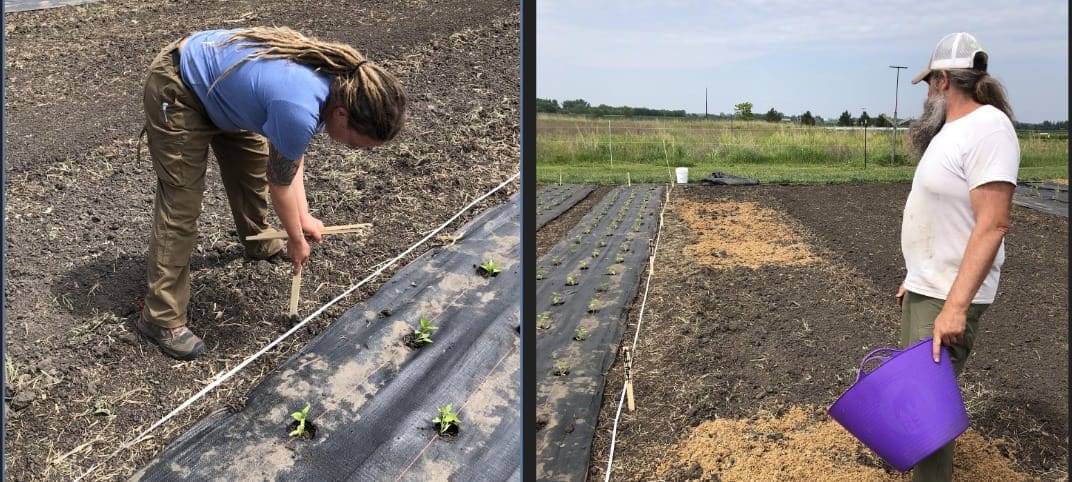
Kate Solko and Kyle Maxwell applying fertilizer treatments and applying plastic mulch before transplanting April 14, 2023.
Methods
Design
Solko and Maxwell investigated two pre-transplant fertilization treatments 1) Sustane 8-2-4 applied at 0.04 lb/ft2 and incorporated into the top 4 inches of soil, and 2) BSG at 1.5 lb/ft2 incorporated with a small walk behind tiller. They planted four randomized replicates of each treatment (Figure A1). Replication and treatment randomization allow for statistical analysis and conclusions about the effect of the treatments on yield.
Measurements
During the harvest season, Solko and Maxwell recorded yield as the weight of all marketable fruit per plot and the number of all marketable fruit per plot. They also recorded the number of unmarketable fruits per plot. Finally, they made visual observations of disease pressure in each plot on each harvest date and assigned them a numeric score where 0=none, 1=some, and 2 = much and documented plant survival.
Data Analysis
To evaluate the effect of the fertility treatments on eggplant yield, we used an analysis of variance (ANOVA) followed by Fischer’s least significant difference (LSD) at 95% confidence. If the difference between the two treatments was greater than the LSD, we considered this to be a statistically significant effect. 95% confidence means that 95 times out of 100, the differences we see between treatments would be due to true differences in the means rather than random chance.
On the other hand, if the resulting difference between the two treatments was less than the LSD, we would consider the treatment results to be statistically similar. We could make these statistical calculations because the cooperators’ experimental design involved replication of the treatments (Figure A1).
Results and Discussion
Survival Rate and Pest Pressure
While Solko and Maxwell were concerned about disease pressure after the heavy application of damp BSG, they observed no disease pressure in either fertilization treatment. However, both treatments experienced heavy pest pressure from potato beetles. While the cooperators did not quantify pest pressure, they noted that the Sustane treatment appeared to recover from pest pressure better than the BSG treatment.
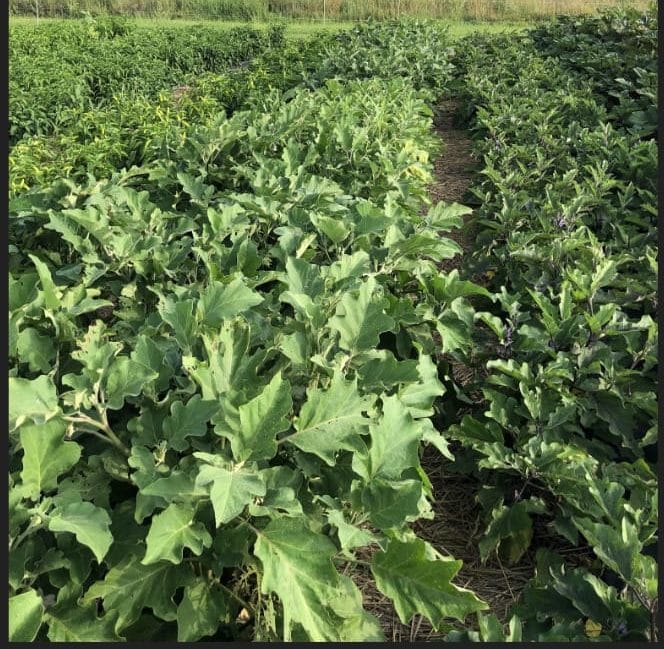
Three of the experiment plots are in the center row of this photo, with clear differences in plant height marking the transition between Sustane plots (front and back) and BSG plot (middle). Some holes in leaves from insect pests are visible. Photo taken by Solko and Maxwell August 22, 2023.
Yield
As shown in Figure 1, fertilization with BSG resulted in more than double the total marketable fruit weight and number of marketable fruits compared to fertilization with Sustane. There was no significant difference in the number of unmarketable fruits between the BSG treatment (16 fruits/plot) and Sustane treatment (21 fruits/plot) (LSD = 11 fruits/plot).
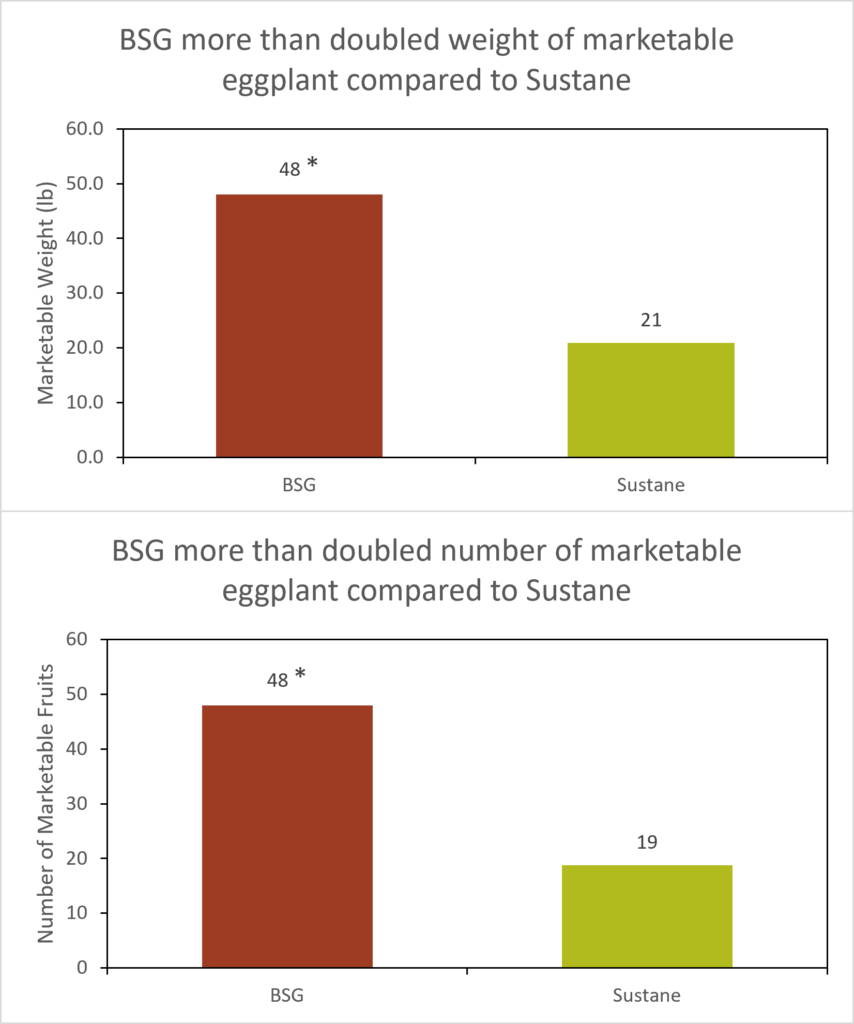
FIGURE 1. Solko and Maxwell assessed eggplant yield in terms of total weight of marketable eggplant harvested (top panel) and total number of marketable eggplants harvested (bottom panel). Asterisk (*) indicates that the differences in yield were statistically significant. Treatment averages are printed above each bar. Least significant difference (LSD) = 28 lb for marketable weight (top panel), LSD = 27 fruits for marketable number (bottom panel).
It is impossible to say what aspects of the fertilizer treatments led to the BSG treatment dramatically outperforming the Sustane treatment in this trial. Solko and Maxwell reported that throughout the summer, the plants treated with Sustane were noticeably bigger and greener than the plants in the BSG plots.
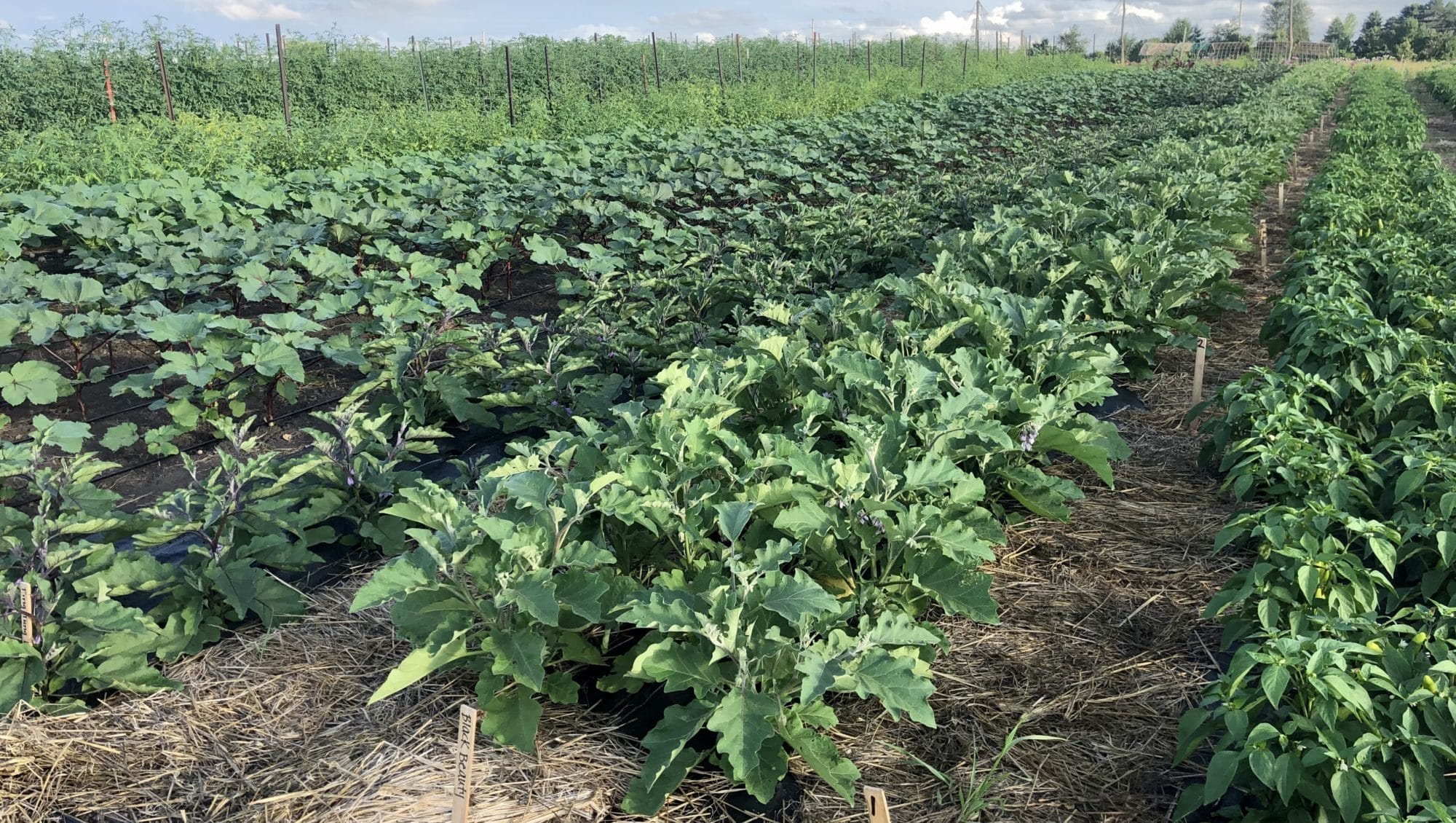
BSG eggplant fertilization trial in early August. Row with all of the experiment plots is in the middle of this picture and there are no visual differences between the treatments. Photo taken August 2, 2023.
Excess nitrogen can cause plants to grow large, very green leaves and can also delay plant flowering and negatively affect fruit production, so it could be that the Sustane application was too high in nitrogen which negatively affected yield.
BSG and Sustane are also very physically and chemically different soil amendments; the BSG applied in this trial was not tested for nutrient content and was a large input of unprocessed organic matter, while Sustane 8-2-4 is a concentrated slow-release concentrated compost product that mostly contains highly accessible N.
These inherent differences make it impossible to assess whether fertilizer nutrient rates, plant nutrient availability, or some other factor such as heat from the decomposing BSG drove the differences between treatments. Regardless of what drove the differences, Solko and Maxwell were satisfied with their initial experiment with BSG and are excited that this waste material seems to be a viable fertilizer for their operation.
Conclusions and Next Steps
Applying 1.5 lb/ft2 of BSG per plot resulted in double the yield in terms of number of eggplants and pounds of marketable eggplant compared to fertilizing with 0.04 lb/ft2 of Sustane per plot. It is not possible to determine what features of the fertilizers or application rates drove this difference in this trial, but the trial demonstrates that BSG can support healthy and high-yielding plants.
Solko and Maxwell are pleased that they “now have a good idea that the waste product from our neighbor will be a benefit to us.” They are eager to keep experimenting with BSG and may trial bioprocessing the BSG through fermentation or composting before application in the coming growing season.
Appendix – Trial Design and Weather Conditions

Figure A1. Example of experimental design used by Solko and Maxwell which included randomized replicated fertilizer treatments. This design allowed for statistical analysis of the results.
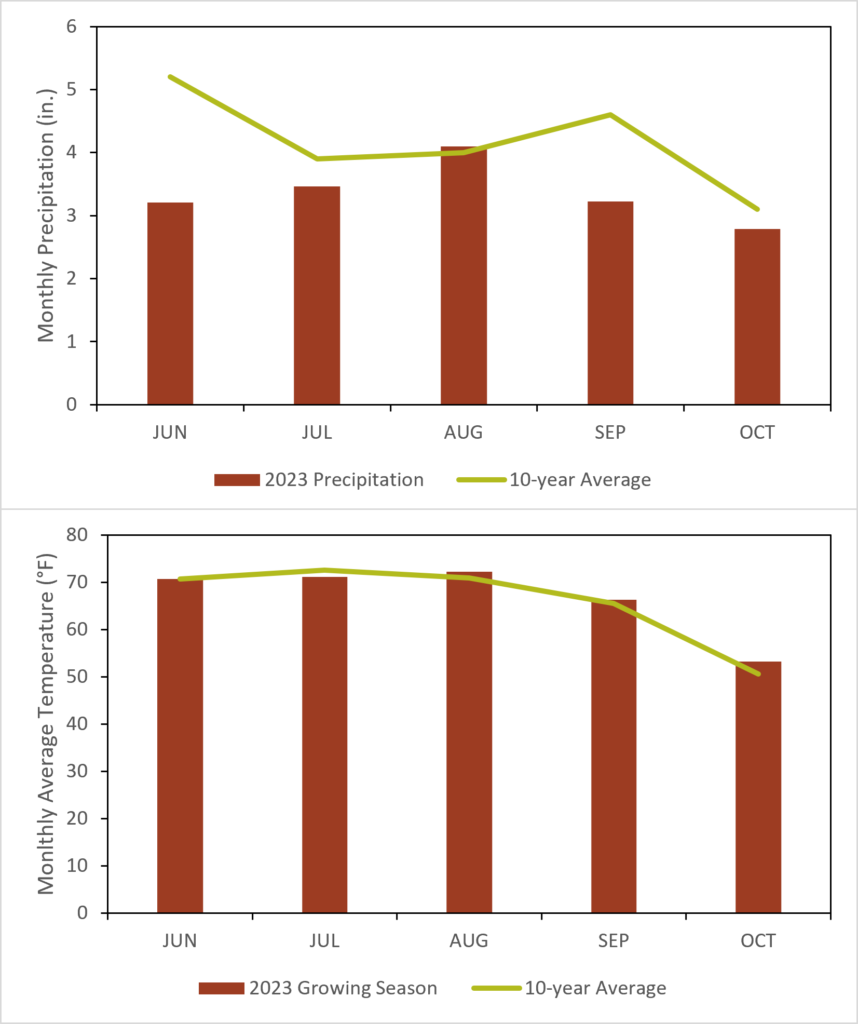
Figure A2. Mean monthly temperature and rainfall during the study period and the long-term averages at the Ames Area weather station (IATAME), the nearest Iowa Environmental Mesonet weather station to Solko and Maxwell’s [3]. Most of the summer was drier than average, and July and August were hotter than the past 10-year average.
References
[1] C. Cacace et al., “Potential of native and bioprocessed brewers’ spent grains as organic soil amendments,” Front. Sustain. Food Syst., vol. 6, 2022, Accessed: Jun. 01, 2023. [Online]. Available: https://www.frontiersin.org/articles/10.3389/fsufs.2022.1010890
[2] A. Biller, “Building soil fertility with spent brewers’ grains.,” Final report for FNE17-864-SARE Grant Management System, 2018. Accessed: May 25, 2023. [Online]. Available: https://projects.sare.org/project-reports/fne17-864/
[3] Climodat Reports, “Iowa Environmental Mesonet.” Iowa State University. Accessed: January 16, 2024. [Online]. Available: http://mesonet.agron.iastate.edu/climodat/


